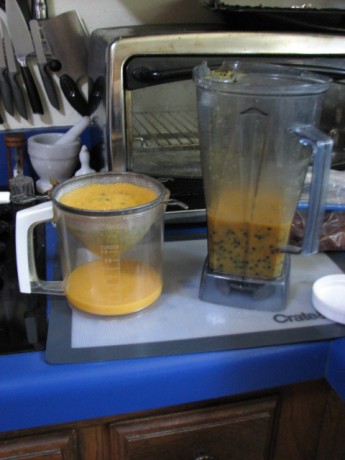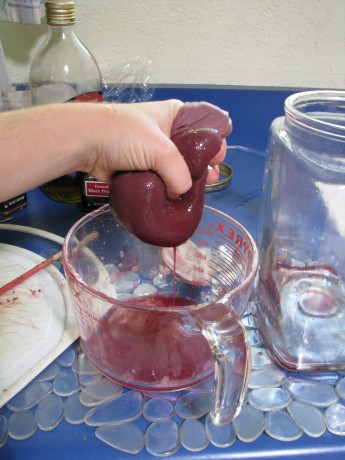Recipes
Tried and true, these are some of my favorites, and some newbies. Come eat virtually with me!
- Compost, Fungus and Mushrooms, Gardening adventures, Hugelkultur, Permaculture and Edible Forest Gardening Adventures, Rain Catching, Seeds, Soil, Vegetables, Water Saving, Worms
Planting Spores in the Garden

The mycelium is white in the sawdust and ready to go. If you remember the trenching, filling and designing the new veggie patch, then this post will make more sense to you.
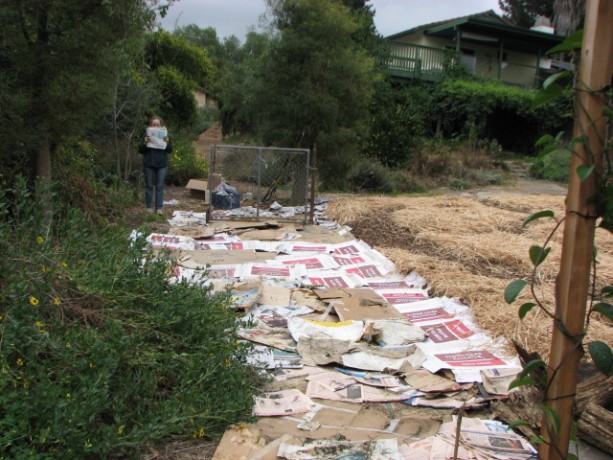
The next step was to cardboard the pathways where Bermuda grass has been taking over, then mulch them as well. The mulch makes it all look so nice!
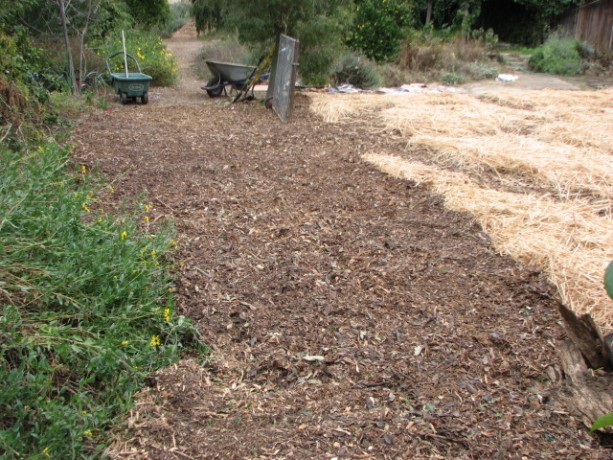
Covered with mulch, the cardboard is only a memory. Next it was time to plant. We’d already transplanted three-year old asparagus, and hopefully not shocked them so much that they won’t produce well this year. The flavor of fresh asparagus defies description.
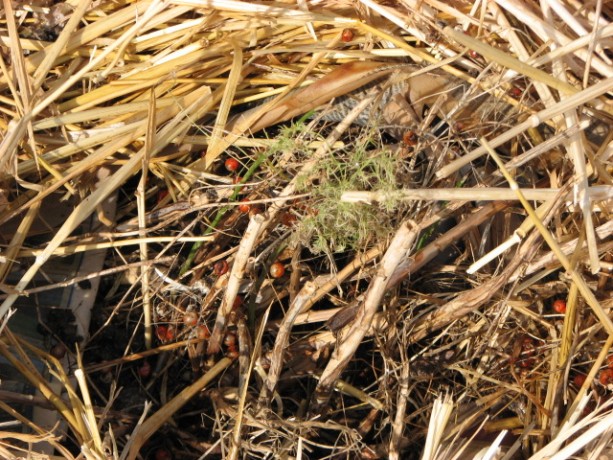
Asparagus popping up some feather shoots from its new home. The strawberry bed was older and completely taken over by Bermuda grass, so it all was buried and I purchased new organic and extremely reasonably priced bareroot strawberries.
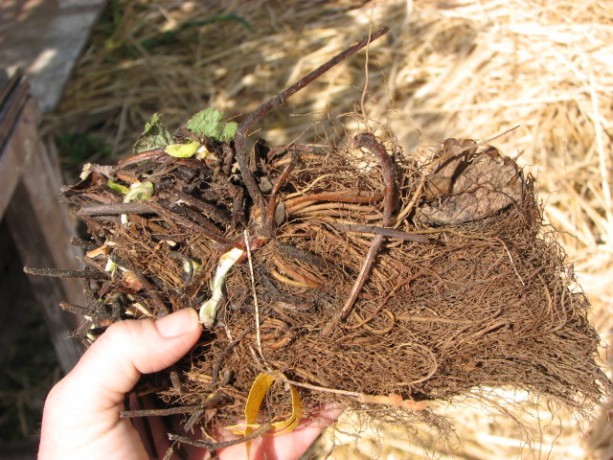
A bundle of twenty-five strawberries. I purchased two June-bearing types and three ever-bearing, heat-loving types, from www.groworganic.com. When they bloom this year we’ll have to nip off the buds so that next year when their roots have taken hold and fed the crown, we can have lots of strawberries.

Soaking the strawberry roots for a few minutes rehydrates them. We planted some in the asparagus bed, which will do nicely as groundcover and moisture retention around the asparagus, while the asparagus keeps the heat off the strawberries. Some we planted around the rock in the center of the garden. The rest will be planted around fruit trees as part of their guilds.
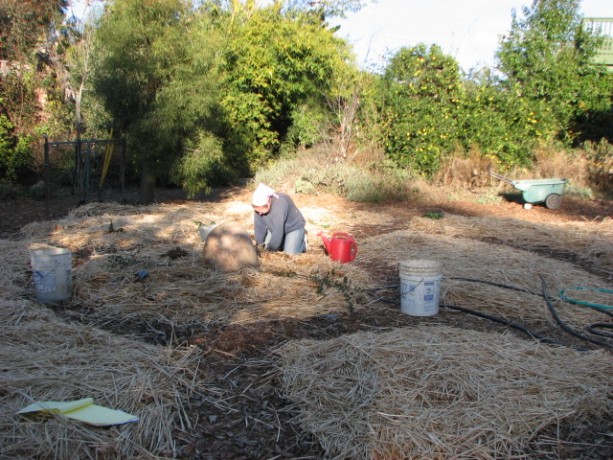
Strawberries surround the rock. We also planted rhubarb in the asparagus bed; these poor plants had been raised in the greenhouse for several months awaiting transplanting.
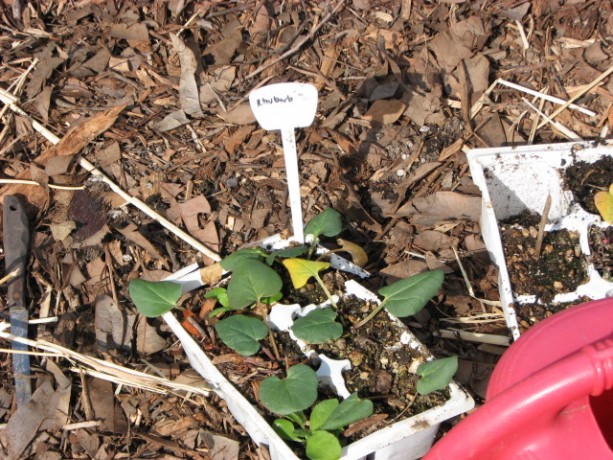
Rhubarb, really eager to be put in the ground. Hopefully the asparagus will protect them from the heat. I plan to raise more rhubarb from seed and plant them in other locations on the property, aiming for the coolest spots as they don’t like heat at all.
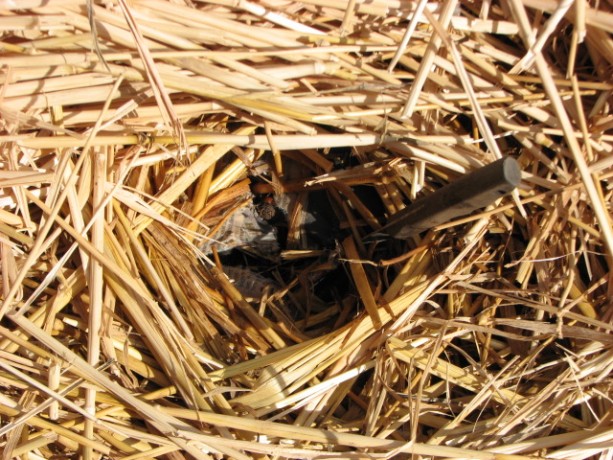
With a strong knife (weak blades may snap) cut a cross in wet cardboard the pull aside the edges. The way to plant through cardboard is to make sure that it is wet, and using a strong knife make an x through the cardboard. Use your fingers to pull the sides apart. Stick your trowel down and pull up a good shovel full of dirt (depending on how deeply your plant needs to go.
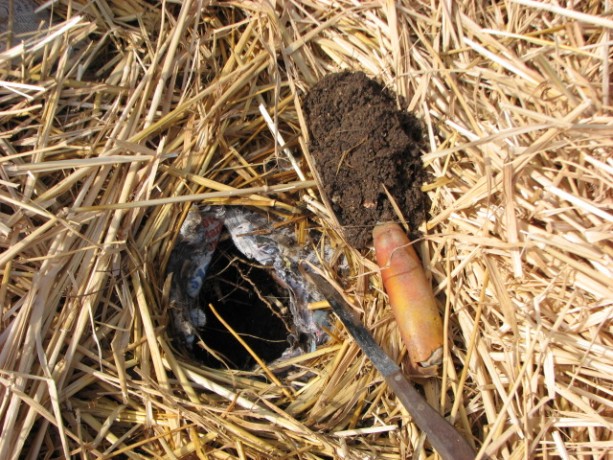
Insert a trowel through the hole and scoop out some dirt. The base of plants and the crowns of strawberries should all be at soil level. Seeds usually go down three times their size; very small seeds may need light to germinate). Gently plant your plant with a handful of good compost, then water it in. You won’t have to water very often because of the mulch, so check the soil first before watering so that you don’t overwater.
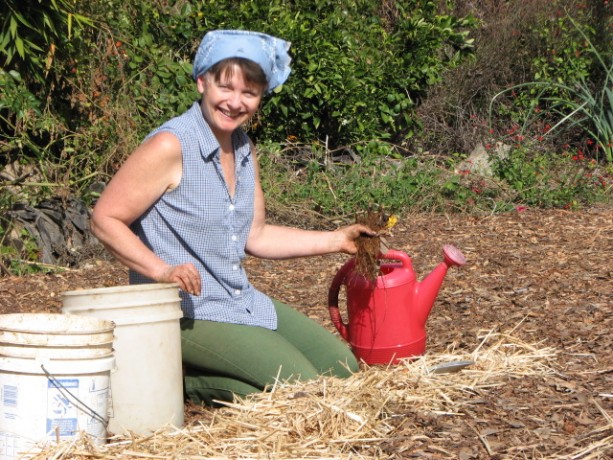
Don’t forget to water in the plants! For the first time in years I ordered from the same source Jerusalem artichokes, or Sunchokes as they’ve been marketed. They are like sunflowers with roots that taste faintly like artichoke. We planted some of them in one of the quadrants, and the rest will be planted out in the gardens, where the digging of roots won’t disturb surrounding plants.
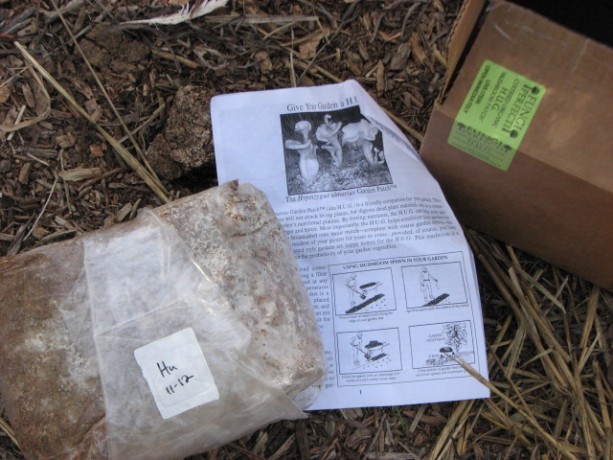
The oyster mushroom kit, or H.U.G. You’ll have to visit Fungi Perfecti to read up on it. Most excitingly, we’ve purchased mushroom spores from Fungi Perfecti, which is Paul Stamet’s business, the man who wrote Mycelium Running and several other books about growing mushrooms for food and for health. We bought inoculated plugs, but that will be another post. Almost as exciting are the three bags of inoculated sawdust to spread in the garden! They sell an oyster mushroom that helps digest straw and mulch, while boosting the growth of vegetables and improving the soil. You also may be able to harvest mushrooms from it! Talk about a wonderful soil solution, rather than dumping chemical fertilizers on the ground!
We’d already covered our veggie beds with wet cardboard and straw.
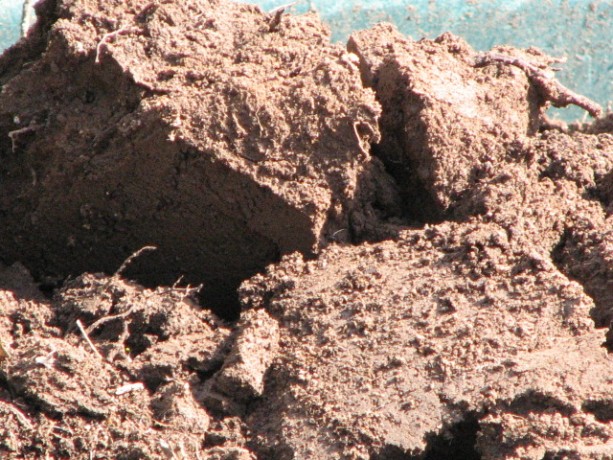
Really good soil from what is now a mulched pathway. To give the mycelium a good foundation I dug up good soil from one of the field beds, which needed an access path through the middle. By digging out the path I created new water-holding swales, especially when filled with mulch.
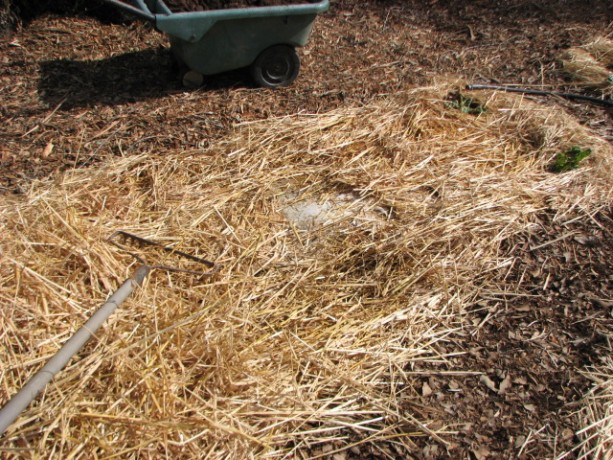
We pulled aside the straw. In the veggie garden we raked back the straw and lightly topped the wet cardboard with soil. On top of that we sprinkled the inoculated sawdust.
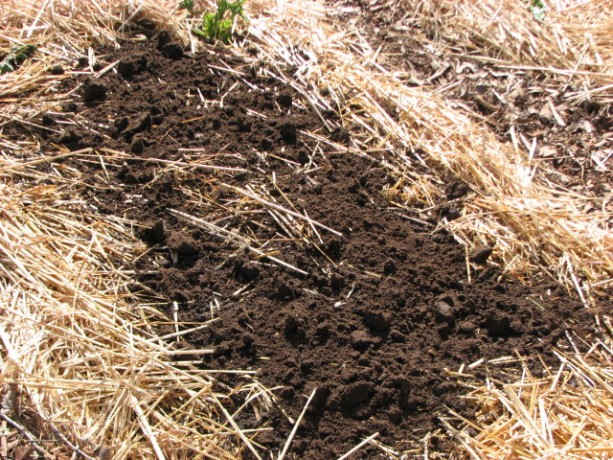
Good soil over cardboard. On top of that we pulled back the straw and watered it in.
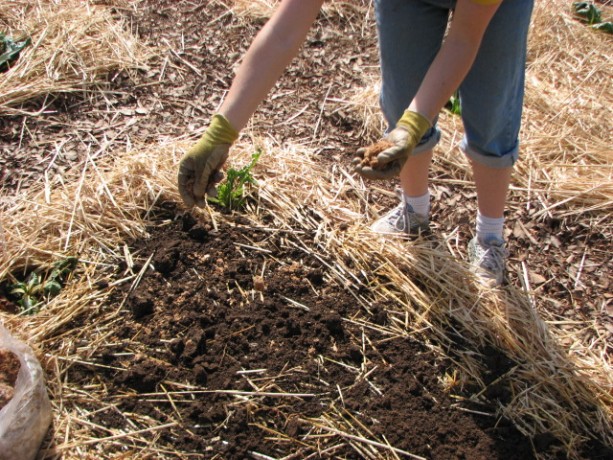
Sprinkling spore-filled sawdust over the soil. The fungus will activate on the wet soil, eat through the cardboard to the layers of mushroom compost and pidgin poo underneath that and help make the heavy clay beneath richer faster.
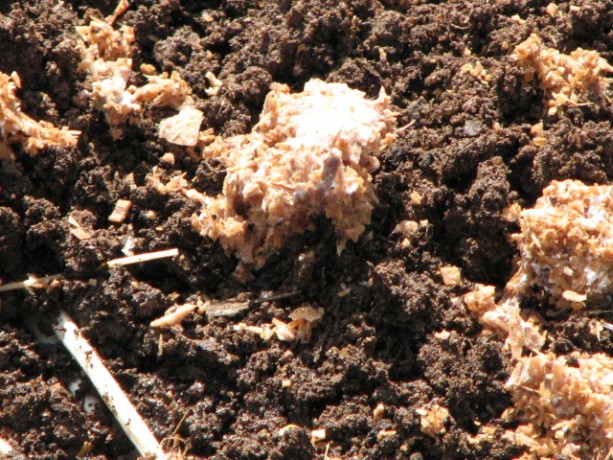
The fungi will immediately begin to colonize the wet soil. We treated the two top most beds which have the worst soil, the sunchoke bed and the asparagus bed. In four to six weeks we may see some flowering of the mushrooms, although the fungus will be working even as I sit here. There are several reasons why I did this. One, it is just totally cool. Secondly, there is no way for me to purchase organic straw. By growing oyster mushrooms in it, I’m hoping the natural remediation qualities of the oyster fungus will help cleanse the straw as it decomposes. Oyster mushrooms don’t retain the toxins that they remove from soil and compost, so the mushrooms will still be edible. Fungus will assist rebuilding the soil and give the vegetables a big growing boost. I know I’ve preached that vegetables like a more bacterial soil rather than fungal. This is true, except that there are different types of fungus. If you put wood chips in a vegetable bed, you’ll activate other decomposing fungus that will retard the growth of your tender veggies; the same wood chips around trees and woody plants will help them grow. However these oyster mushrooms will benefit your veggies by quickly decomposing compost and making the nutrients readily available to the vegetables. Their hyphae will help the veggie’s roots in their search for water and nutrients, too.
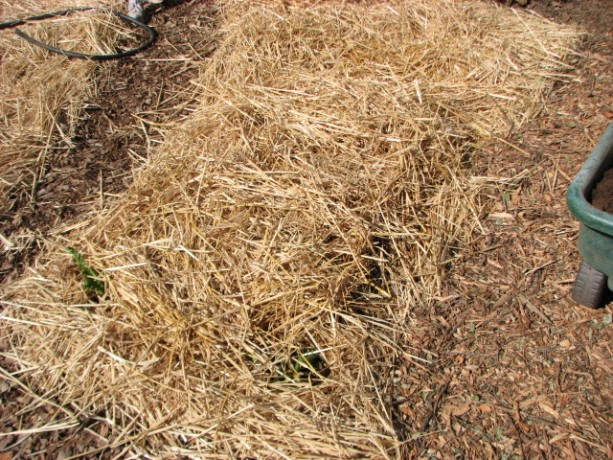
Straw is over the top and watered. We can continue to plant in the beds as the fungus does its magic. The other two bags of inoculated spores are for shaggy mane and garden giant, which we’ll find homes for in compost under trees. More on that as we progress. It is so nice to be planting, especially since these are perennial plants where the most work is being done now. Now we just need some rain!
- Compost, Gardening adventures, Hugelkultur, Permaculture and Edible Forest Gardening Adventures, Rain Catching, Soil, Vegetables
The Sunken Bed Project, Part 3
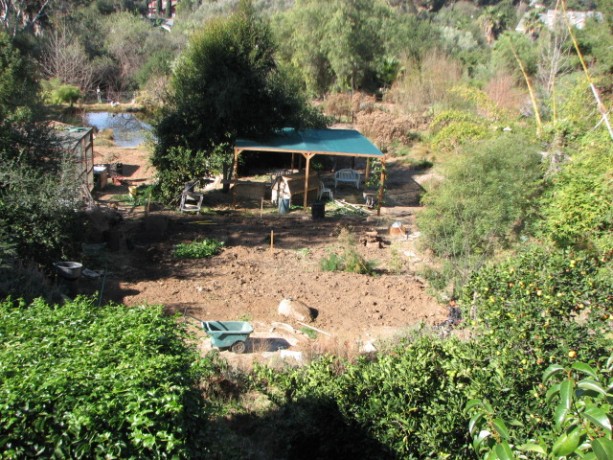
The un-raised bed as of this morning. Today my daughter and I made good headway in the completion of the garden. In the morning the bed still had some veggies that needed transplanting, the ground needed smoothing, the giant clumps of asparagus plants we’d hauled out needed to be planted right away because they were already trying to come out of dormancy, and we certainly didn’t want to lose this spring’s crop.
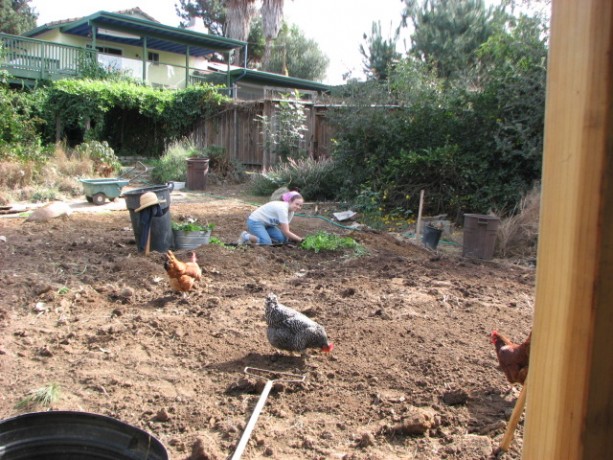
Transplanting and some fine-tuning by the girls. We let the girls loose since we were watching out for coyotes. They loved the grubs and unfortunately, the valuable worms too. Lark, the barred rock in the foreground, was up to her old tricks of jumping onto my shovel and quickly kicking half the dirt off in search of bugs. Miranda painstakingly dug up lots of salad greens for transplanting. We both dug up and pulled out lots of Bermuda grass as we went. The trash cans are full of it.
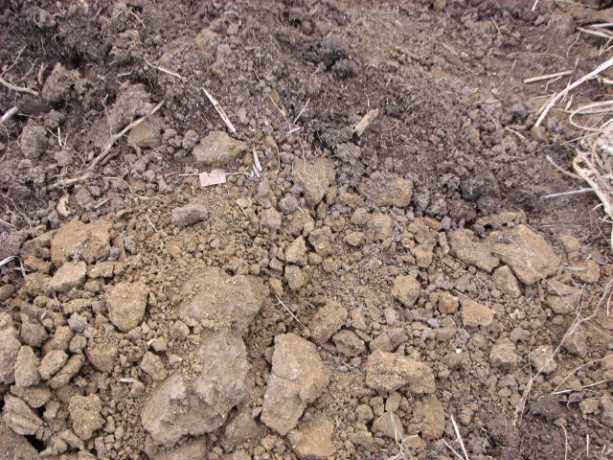
The difference between the heavy clay and the good garden soil is striking. While digging those 2 foot deep trenches we unearthed a lot of clay. On the surface the colors of what had been good garden soil next to what lay under it was very clear. With the deep hugelkultur beds and the sheetmulching, all this clay will be turned into microbial rich soil.
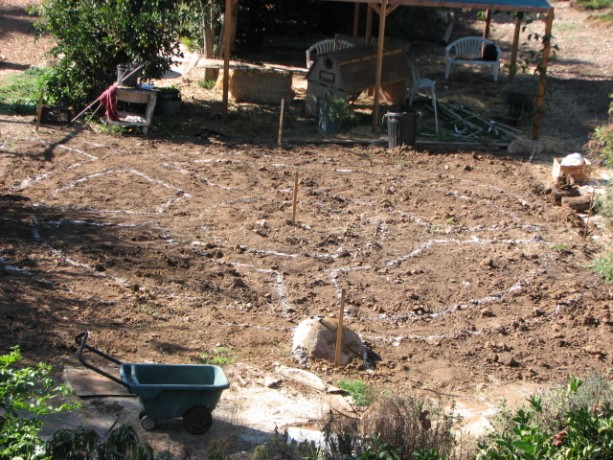
We measured off and marked the pathways and beds with gypsum. Finally we were able to measure off and draw out the design of the garden. We used gypsum which is good for the soil. So many people use spray paint to mark the ground… just don’t! Toxic fumes and toxic chemicals in the soil. If you don’t have gypsum, use flour! The light is bright in the above photo so you can’t see the design so well. We had carefully drawn out several designs on graph paper. An intricate Celtic design was the most favorable one until I’d realized the garden wasn’t square but rectangular. It was just as well because it would have been a nightmare of measuring. This one has 2′ wide pathways from prime entry angles (a wheelbarrow can fit), each planter bed is easily reached from all sides, and the circular design is pleasing and fun.
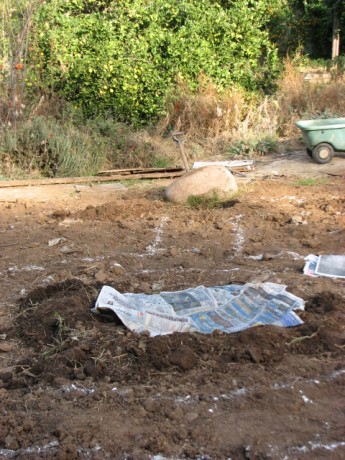
There was this rock…. There was a big flaw in the plan. There was this boulder that had been placed during the original construction of the garden. It didn’t serve a purpose, it was always in the way, it was a shelter for Bermuda grass, and it wasn’t attractive. Now it was at the head of one of the pathways. It had to go. My daughter and I decided to move it to the center of the garden. After transplanting the heavy batches of asparagus, we dug out a hole for the rock to sit in; when placing boulders it is visually more attractive if the boulder is buried at least a quarter of its size into the ground to look natural. We placed wet newspapers around the hole so that the boulder would sit on them and they would block Bermuda grass from emerging.
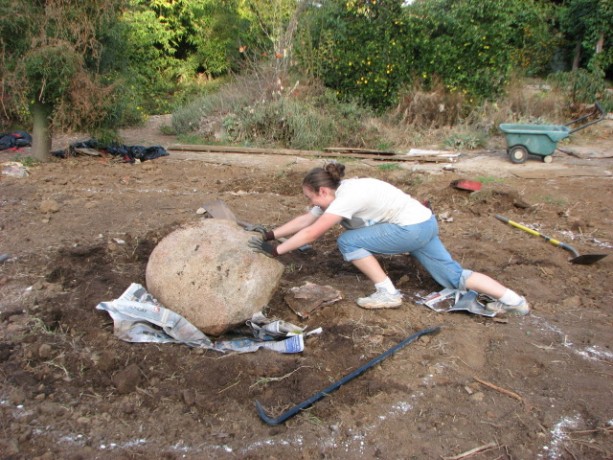
One of the methods used to move the rock, and build up good bone density and muscle. Although the garden was sloped down from the boulder, the rock wasn’t round and didn’t want to roll. We dug out a pathway for it, and using a long crowbar and a digging bar we managed to turn it over. We pushed and heaved and balanced and flipped it until it was right at the rim of the hole, and then things became difficult because it wasn’t positioned in the way we wanted it. The rock has a flat side, and is long. Miranda suggested that the tall side should stand up for birds to perch on, and I liked the Half-Dome look to it. We heaved the rock into the hole, then walked it around, tipped it up, centered it, and eased it into place, using the bars and all of our strength. Luckily the boulder didn’t roll on a foot, or the bar slip and break my collarbone. Finally we tiredly decided that the position it was in was good enough and we were both happy. Exhaustion had much to do with this decision. Miranda propped it up with clay chunks as I held it in place with the digging bar, then backfilled around it. It looks fantastic; a good central point for the garden, and a source of thermal retention.
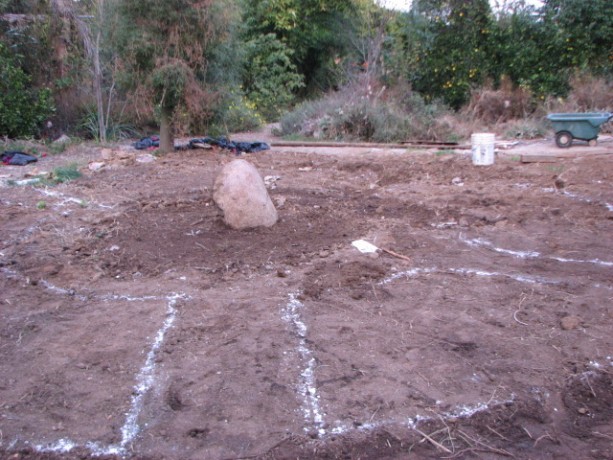
The rock in place, gathering positive cosmic forces and good karma. At least, I hope so. We messed up some of our pathway lines, but we can easily redraw them. The sun was setting and the mosquitoes humming; the Pacific chorus frogs began calling by the hundreds, and the wigeon came in to feed on the pond. There were still chores and dinner to be had, but exhausted as we were, we were pretty darn proud of ourselves for moving that big guy by ourselves. Next comes the sheet mulch.

A Maxfield Parrish sunset. - Compost, Gardening adventures, Hugelkultur, Permaculture and Edible Forest Gardening Adventures, Rain Catching, Soil, Vegetables, Water Saving
The Pros and Cons of Raised Beds
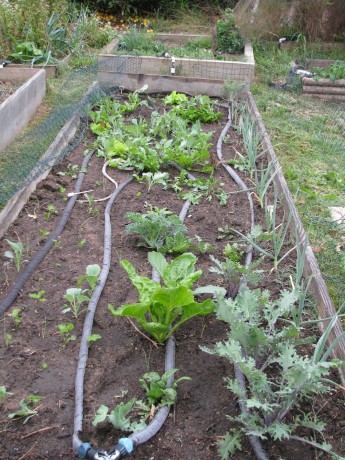
The raised beds. Raised garden beds can be wonderful things. They also can be inappropriate. I’m in the process of taking ours down and replacing them with… well, I’ll describe it later on. Let’s get back to the pros and cons of raised beds.
Here are some of the pros:
Raised beds look just great. They are neat, tidy, organized and restful to the eye.
If raised high enough they are accessible to those who can’t work on the ground or bend over, and to those who are non-ambulatory.
If lined with hardware cloth they keep gophers and mice from tunneling under your food and making it magically disappear.
They help with some weed control.
If you live in a rainy area, they help with drainage.
If you have miserable soil, you can garden anywhere by building a raised bed without having to dig.
If you live in a cold area, depending upon what materials you use for the sides of the raised beds you can tap into the thermal heat and have warmer soil longer.
You can build reusable covers for the beds and turn them into cold frames, or shade structures.
Now here are some of the cons:
You need to fill raised beds with a lot of soil, and if you have to buy it, that is a large expense. The soil will compact and disappear over the course of a year, so you have to keep topping up the beds to keep the soil level high. Heavy work that is expensive.
Wire underneath the raised beds will last a few years and then will be compromised by rodents, so the bed will have to be emptied and rewired if rodents are a problem.
If you live in a warm, dry climate, the sides of the raised bed acts like a clay pot. It will wick moisture from the dirt and heat the dirt up so that plant roots around the perimeter will cook.
If you live in a warm climate you have to pour on the water because of the point mentioned above; a raised bed dries out much more quickly than in-ground gardens.
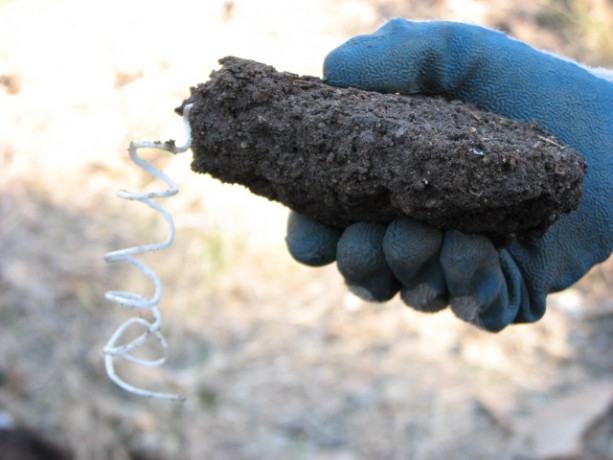
We are wealthy in clay. A Bermuda grass root hangs like a piglet’s tail from this clump. I built raised beds from old bookshelves many years ago, and that was my only veggie garden on the property as I raised my children. I’d grown plants in-ground before that, trenching and turning, and losing the fight against gophers and Bermuda grass. The raised beds were lined with wire. For awhile it worked, but the Bermuda grass took over and infiltrated all the beds. The wire began to rot and rodents chewed away at the sweet potatoes. Worst of all, the soil level would decrease, and since the beds weren’t very deep, then root veggies would grow into the wire and I’d lose half of them as they broke off during the harvest. I couldn’t keep up with refilling the beds. I composted in place, buried wood and vines, and that worked well, but I still needed to add compost. The beds drank up water during our long, hot summers.
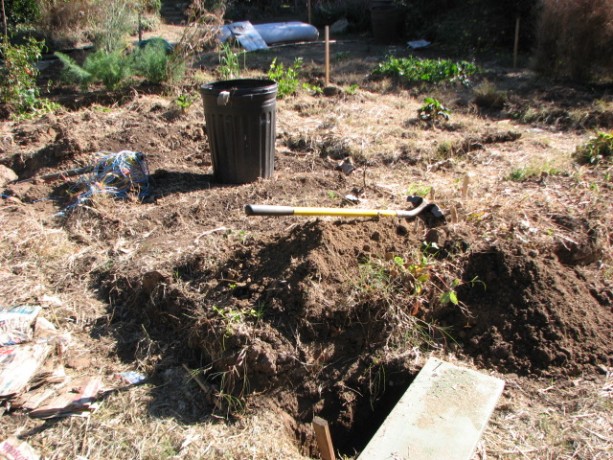
The trenching begins. This summer I realized that I was using a gardening technique that was best suited to rainy climates. Here in the dry Southwest, a traditional gardening method was to plant in sunken beds. We need to capture water, not make it run off. Also, the Bermuda grass became so invasive that I realized that only sheet mulching would make any difference in controlling it.
Of course I decided that my daughter and I couldn’t possibly have an easy winter, but must rip out the beds and start digging.
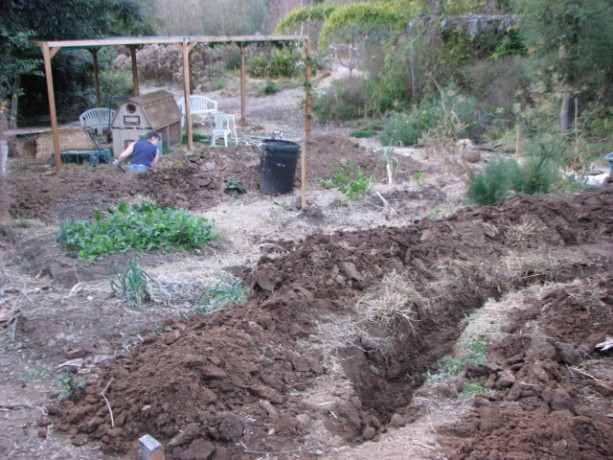
In the trenches. I’m an advocate of no-dig gardening; however sometimes you have to dig bad soil to create good soil. The no-dig policy can happen once the infrastructure is in place. So here’s what I’m planning on doing: I’m combining hugelkultur with sunken gardens and sheet mulching to create what I hope will be a veggie garden with a much lower water consumption, and weed-free.
First we determined the direction of water flow down the hill, and planned on creating trenches that would capture that water. The trenches, or swales, would need to be level on the bottom so that any water flowing in from the downhill side, would travel all along the swale even to the drier side, where the surface soil was higher. We created a bunyip to estimate the difference in slope between the top and bottom of the garden. Although I had drawn up intricate plans for a square garden, that shape just wouldn’t work so we went with a rectangle. Then we began to dig. The first ten inches wasn’t bad, but after that we hit clay. I had to buy a mattock. I also ended up icing my back for a couple of days. Some of the clay we’ll save for use on any future earthworks we may want to do, and some we’re saving for an artist friend.
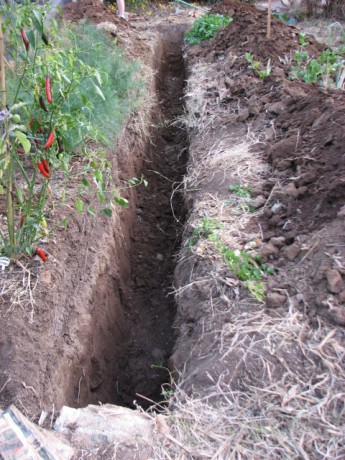
The soil was good for about ten inches, then we hit clay. The trenches are two feet deep, and about one to one and a half feet wide. It is amazing how you start out large, and then after a few very hot afternoons scraping clay and throwing it up and over four feet, the trenches become more narrow. My plan is to fill the bottom foot of the trenches with old wire, wood, branches, old textiles and other biodegradable debris. The old wire will rot, and will also help repel gophers. On top of all this will be layered some of the clay, and watered in with compost tea brewed in the 700-gallon water tank that is full of rainwater from the last rain (two months ago!). On top of that will be good soil, smoothed below the surrounding surface level. Water from the road will be diverted into the swales, which will allow it to flow across the garden and be absorbed by the fill materials. But what about the Bermuda grass? There isn’t a mountain of cardboard all over my garage for nothing! The entire garden will be sheet mulched, and all veggies will be planted through the cardboard and newspaper. The existing asparagus bed will need to be carefully relocated, but everything else can either be harvested or dug under.
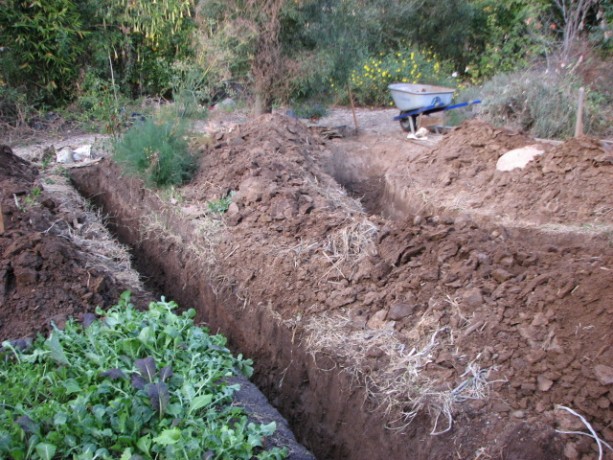
These first two trenches will collect rainwater from the pathways and channel it the length of the garden. That’s the plan, anyhow. I’ll let you know how it goes.
- Beverages, Breakfast, Fruit, Permaculture and Edible Forest Gardening Adventures, Recipes, Vegetarian
The Passion of the Fruit: Homemade Juices
Hi there. It’s Miranda the Guestblogger again, and today I want to talk to you about juice. You know, The Big Drip – Drosophilid Milk, Agua Fresca, Drupe’s Tears, Essence of Mesocarp: JUICE.
Here at Finch Frolic Garden, we like a nice fresh juice. As I am officially the FFG Harvester (a.k.a. Fruit Maven), I also take on the mantle of One Who Figures Out What To Do With Some Of The Stuff That’s Been Harvested – and let me tell you, that’s not a title to take lightly.
In the summer, it’s hard to keep up with all the produce and we hate to waste anything, even though spoilt food just goes back into the soil via compost here. We really like to get our produce into our mouths, though. Therefore, a lot of our fruit bounty gets juiced and frozen to keep. I want to walk you through some of our juiceplorations.
Finch Frolic Redoubtable Fruit of Almost Every Month in the Year: the Purple Passionfruit. These exotic and fragrant fruits are dropped by the bushel-load from our vigorous vines almost continuously, but overwhelmingly in midsummer. I pick them off the ground under the vines and wait for their smooth purple shells to wrinkle over in ripeness. Then the process begins.
I sit down for this and usually bring up a show on my laptop, because it takes a while. I have the bag or bowl of fruit on my right and a plastic bag looped over the back of a chair on the other side for the empty shells.
A fruit is picked up, dipped in a bowl of water, then wiped quickly on a paper towel and deposited on a cutting board that has a little rim on it to catch juice.
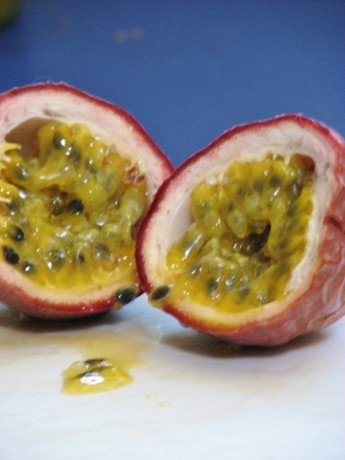
With a sharp knife, I halve the fruits and use a spoon to scoop the many little packets of bright gold-orange juice and hard black seeds into a bowl. Those packets have to be broken to get the juice.
I used to press the pulp into the mesh of a sieve with a spoon, but that’s hard on the hands and on the sieve. Now, I throw it in our Vita-Mix and turn it up to 3, tops – you want to spin all the juice off the seeds, but you don’t want to chop up the seeds. I judge whirl completeness by whether or not the little black seeds are free-floating as they sit in the mixture.
Then I run it through a sieve to separate out the juice.
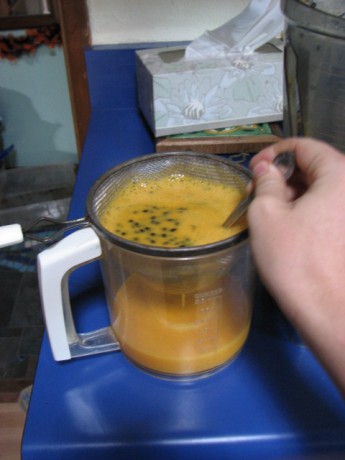
To get the most juice out of it, you swirl a spoon through the pulp as it sits in the sieve. 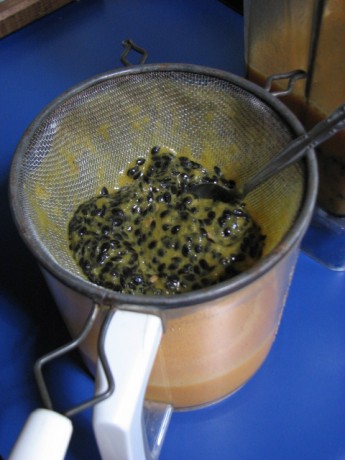
All juiced out. This sounds very labour-intensive – and it is – but it’s worth it to us to use our fruit. We don’t eat passionfruit straight – the seeds are a little too gross. We do, however, use the juice in anything we can make an excuse to, and it keeps frozen into cubes for a long time. And the leftover seeds make a fun treat for our hens.
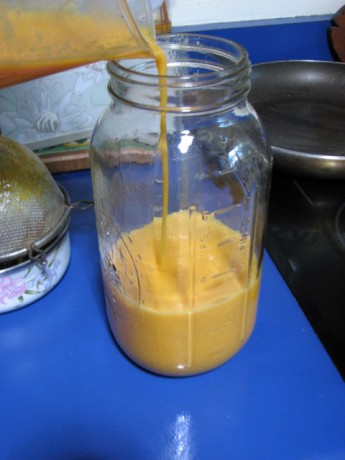
Glowing, beautiful, tangy, fresh passionfruit juice! In the fall, we’re overwhelmed with lovely big pomegranates from our one big pomegranate tree. This year, we’ve had more than ever and we didn’t want to waste any.
Once harvested, though, the poms need to be processed. Diane and I camped out every evening for a couple weeks cutting poms in half and hand-picking the arils. Recently, after a friend let us try out her juicer, we acquired one for ourselves, eliminating the need for the rest of the process with poms, but it is the same process I still use for grapes, apples and melons, so I’m going to tell you about it anyway.
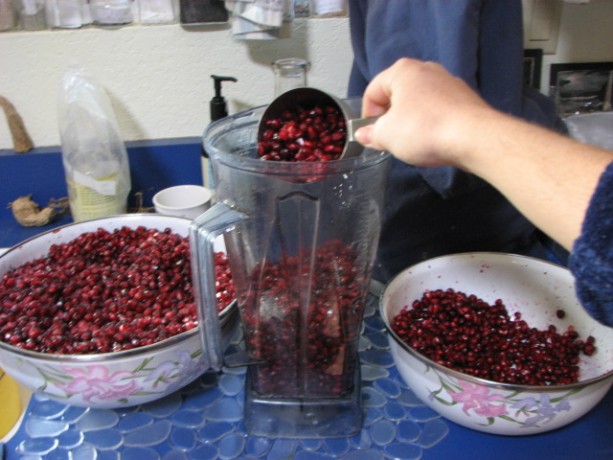
I put the arils in the Vita-Mix and turn all the way up to completely blend the seeds. The blended pom also gets strained, but because the particles are finer than the passionfruit pulp, a mesh sieve isn’t sufficient. No, what you need is a sock.
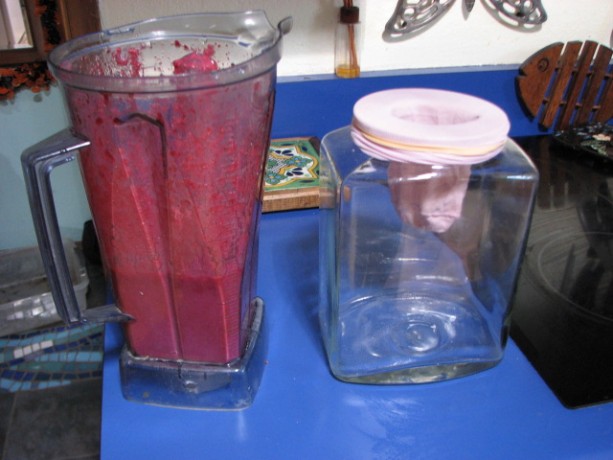
A nice clean women’s nylon sock is perfect. 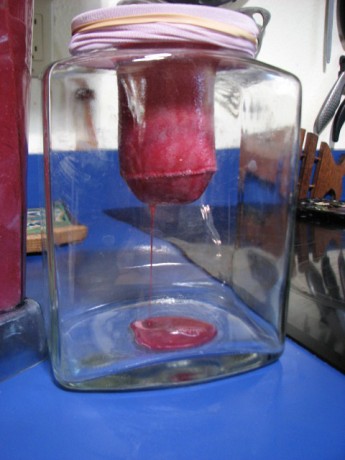
Hanging allows pure juice to come through. To get all the juice out, though, squeezing is necessary, and that puts a little more must in the juice, like fine fruit silt.
It’s also very taxing on the hands, because the sock must be hand squeezed, but it helps get the most juice from the fruit. This second straining produces interesting dry, crumbly must that comes out of the sock like purple Play-Doh.
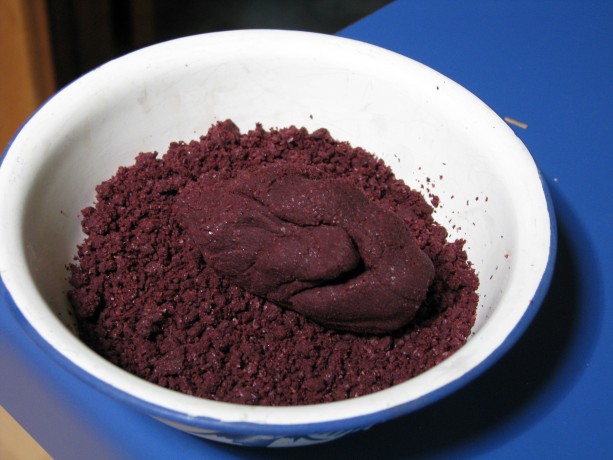
Also a salutiferous treat for the hens! Like the passionfruit, we use the pom juice as much as we can. For instance, we reduced the juice and I experimented with some pomegranate ice-creams:

Chocolate makes an excellent palate cleanser, if you ask us. I also diluted the concentrate with water to make a lovely breakfast juice. We even poached pears with the juice for Christmas dinner – a lovely rose colour and delicate fruity flavor.
The fun never ends with fruit!
So, that’s a little peek at the juiceinations that go on here at Finch Frolic. Happy juicing to you!
TTFN!
Miranda the Fruit Maven
-
Thai Coconut Soup with Tofu and Mushrooms

A comfort food without the high caloric price tag. This is a soup recipe that has been requested by friends, and is so good that I crave it. So I share it with you. Wonderful even during the summer, it also is fantastic comfort food when sick or on a cold day. You can tweak this dish with lite coconut milk, lime zest instead of lemongrass, or if you have access to Thai ingredients use kaffir lime and Thai basil.

Lemongrass is easy to grow and to use. Just the base of the peeled stalk is used as a flavoring. Cut it only in half so the pieces are easily found in the soup and put aside. I’ve had it without tofu, and without mushrooms, and it is still wonderful. Put the lime in the coconut, and drink it all up! Don’t put too many extra veggies in it; it is a simple soup.
Thai Coconut Soup with Tofu and MushroomsAuthor: Diane C. KennedyRecipe type: SoupCuisine: ThaiPrep time:Cook time:Total time:Serves: 4A simple, delicious vegetarian Tom Kha soup. The lemongrass isn't meant to be eaten because its too tough. The kaffir lime leaf may be eaten only if you use a young one and slice very thinly before adding it.Ingredients- 1 can (1 ½ cups) unsweetened coconut milk
- 2 tsp. grated fresh ginger
- 1 fresh lemongrass stalk, peeled and halved (or 2 tsp. dried, or 1 tsp. lime zest)
- 1 bruised fresh or dried kaffir lime leaf, (if young can be sliced very thinly(or ½ tsp. lime juice)
- Two - three Thai basil leaves (optional)
- 3 cups mild vegetable stock
- ½ to 2 teaspoons Thai red curry paste, or Thai coconut curry paste, or curry powder (depending on hotness desired)
- 1 package (12 – 14 oz) extra firm tofu (not silken)drained and cut into small cubes
- 15 oz canned straw mushrooms, drained and rinsed, or half-cup sliced button mushrooms
- 2 tsp. sugar or other tasteless sweetener
- 2 Tablespoons light soy sauce (I use Bragg’s Amino Acids instead)
- Salt to taste (opt.)
- Fresh lime juice to taste (opt.)
Instructions- Combine lemongrass, ginger, kaffir leaf, Thai basil leaves, and coconut milk with broth in a large saucepan and bring to a boil.
- Reduce heat to medium-low and simmer for 5 – 10 minutes.
- Add the curry paste a half-teaspoon at a time, stirring well and tasting for desired hotness.
- Stir in the tofu, mushrooms, sugar, and soy sauce.
- Simmer for about 10 minutes more.
- Taste before adding additional optional salt.
- Serve as is or over hot rice.
- Offer fresh lime to squeeze on top as desired (it makes the flavors pop).
- Animals, Chickens, Cob, Compost, Composting toilet, Fruit, Gardening adventures, Giving, Grains, Health, Herbs, Houses, Hugelkultur, Humor, Living structures, Natives, Natural cleaners, Permaculture and Edible Forest Gardening Adventures, Ponds, Rain Catching, Recipes, Seeds, Soil, Vegan, Vegetables, Vegetarian, Worms
San Diego Permaculture Convergence, Nov. 9 – 10, 2013
There is a fantastic, information-packed permaculture convergence coming up at the beautiful Sky Mountain Institute in Escondido.
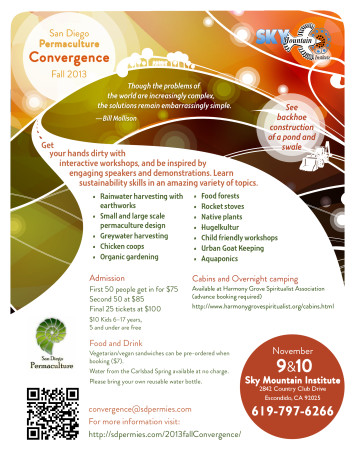 It will be two days packed with great information for a very reasonable price; in fact, scholarships are available. Check out the website at convergence@sdpermies.com. On that Sunday I’ll be teaching a workshop about why its so important to plant native plants, how to plant them in guilds using fishscale swales and mini-hugelkulturs. Come to the convergence and be inspired!
It will be two days packed with great information for a very reasonable price; in fact, scholarships are available. Check out the website at convergence@sdpermies.com. On that Sunday I’ll be teaching a workshop about why its so important to plant native plants, how to plant them in guilds using fishscale swales and mini-hugelkulturs. Come to the convergence and be inspired! - Gardening adventures, Permaculture and Edible Forest Gardening Adventures, Recipes, Vegan, Vegetables, Vegetarian
Dinner with the Pandas: Harvesting Your Own Bamboo
Hello.
Before you cry, “Imposter!”, let me assure you that I have authorization to be here. Mostly. I happen to be Diane’s daughter Miranda, guestblogging and wordsmithing for you today. You might recognize my powdery feet or recollect me when keeping company with chickens (or from diverse other adventures). As much as I enjoying rolling in dust and home decorating with hens, today I’m here to talk about an unusual topic for Vegetariat – food.
The handy rhyme isn’t the only reason I’m sometimes known as Miranda the Panda – I also have a great partiality for a bit of bamboo, much like the vegetarian carnivore from whom I draw my catchy moniker. Luckily, we happen to have a fair bit of the stuff around Finch Frolic these days (bamboo, not pandas). Bamboo shoots are a common – and delicious! – component of Asian cuisines, and bamboo has been used for many culinary purposes, such as flavoring rice, wherever it grows. During this past summer, I was overcome with the need to find more things to eat on the property and began a foray into harvesting our own bamboo shoots.
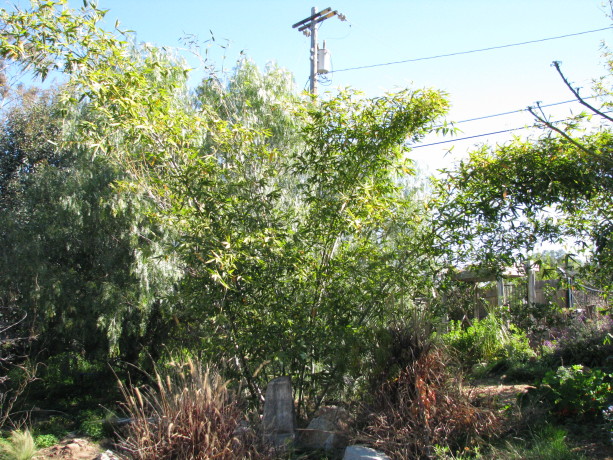
Our giant species of bamboo arches over many of our paths — perfect for building material, and any shoots that venture into the soil of the paths are prime targets… 🙂 Before I stepped outdoors and started gnawing on the nearest clump, I had to be sure that our bamboo is an edible variety, and hopefully a tasty edible variety. You need the scientific name of your bamboo for that, but once we ferreted out ours (Bambusa beecheyana), it was easy to find notation of its edibility and delectability online. One helpful and extensive listing is on Guadua Bamboo. Happily, there is a large number of edible and tasty bamboo species.
Proof of mange-ability in hand, the next obstacle was divining the best way to get bamboo shoots from the ground to my mouth. Harvesting can be more or less of a challenge, depending on what variety of bamboo one has and how it’s established (e.g., moisture and soil conditions, obstacles like stones around it). To harvest shoots, it’s best to pick fat green ones poking no more than a foot above the ground. You want to catch them before they get too woody, but old enough to have a bit of meat on them, so to speak. The shoot is mostly leaf (tightly layered sheaths), so bulkier shoots are more rewarding.
Removing our bamboo from the ground and its parent plant turned out to be on the more side of challenging.
Miranda and Diane bust out the Finch Frolic arsenal on the recalcitrant shoot.
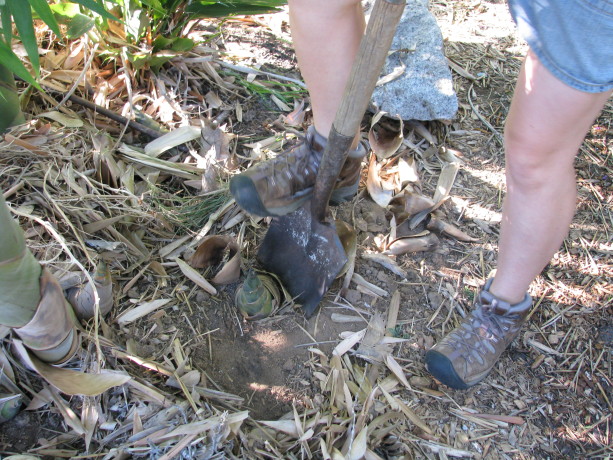
First, the inimitable spade is set to the task. 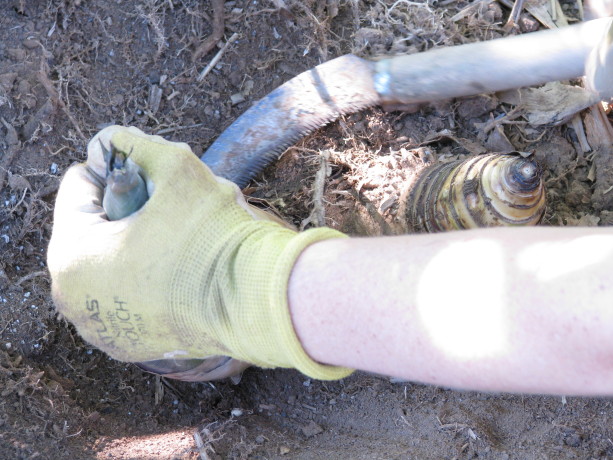
Legs weary and spade abandoned, the small sickle saw is recruited, to little effect. Diane had just returned home and gleefully plunged into the fray, skirt, white sandals and all.
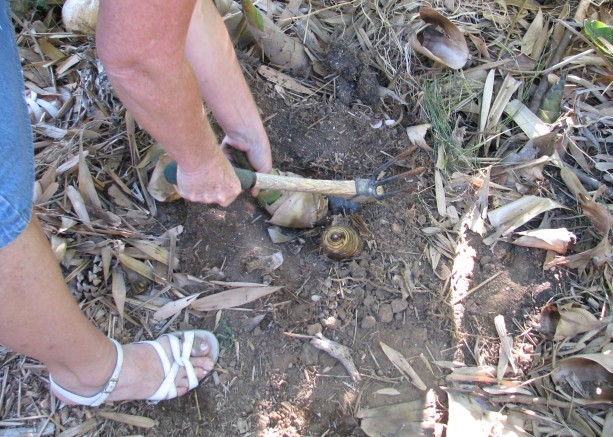
Finally, Diane wades into battle with the winning implement. 
The shoot, freed from the earth and its parent plant. Once we finally achieved success, processing could begin! It is somewhat tiresome to strip a shoot down to the edible white core, because the leaves cling so tightly and are fibrous. It’s like shucking the most stubborn ear of corn in the world. It’s good to slit the tougher outer leaves with a very sharp knife and peel them away.
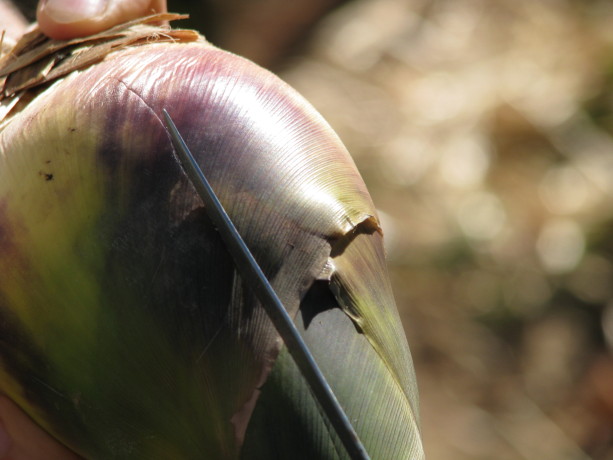
Slitting the fibrous outer leaves with a filet knife. 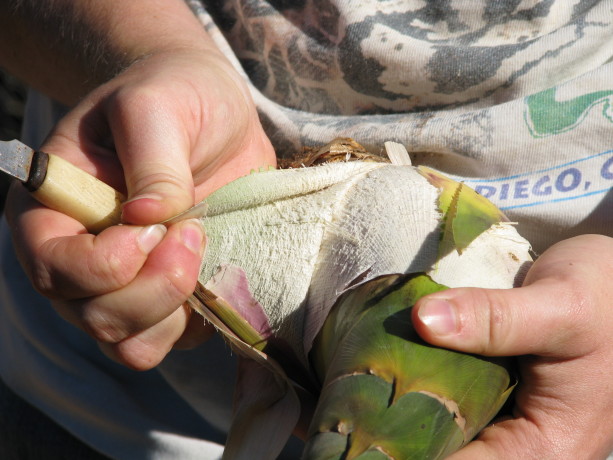
Peeling. The inner leaves come away more easily – rather like the layers of canned hearts-of-palm – as you get closer to the heart of the bamboo shoot. The innermost leaves are basically fetal, and so are edible because they haven’t gotten tough yet. They make the tip of your shoot look hairy.
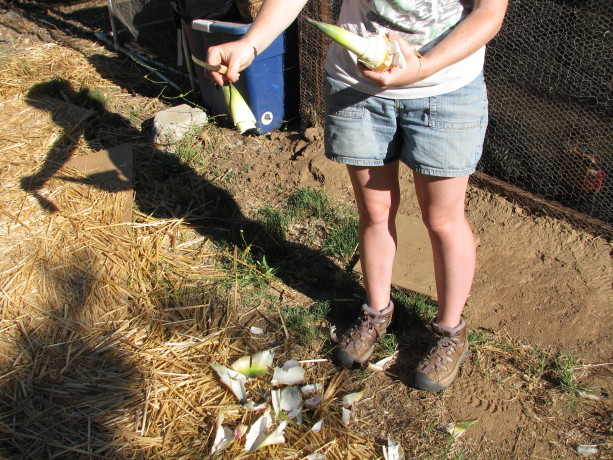
Many layers of increasingly tender leaves. 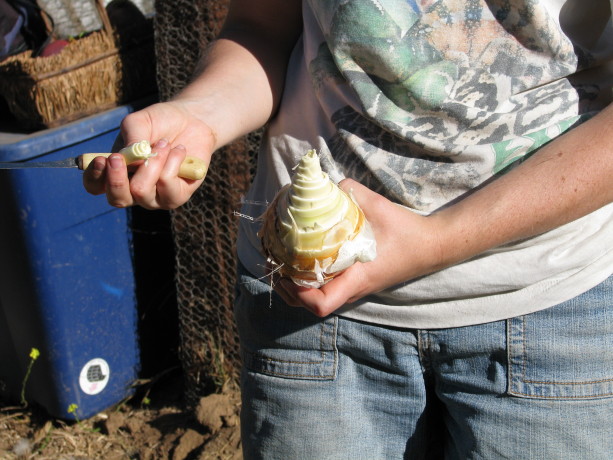
The edible shoot. A peeled bamboo shoot can be cut up in whatever way the chef desires. The shoot grows more fibrous towards the base, where there is probably some inedible hard material. My current rule of thumbs-carefully-tucked-away is if a sharp knife can pretty easily get through it, it’ll be fine to eat.
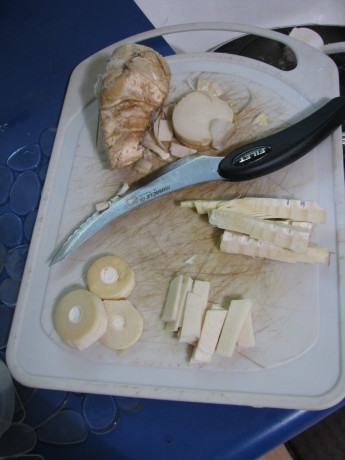
A shoot cut in three different ways. The material behind the knife (upper left) is too fibrous to eat. You just have to boil your slices before cooking and consumption because they contain a mild toxin that dissipates with boiling. The first time, we tried boiling in lightly salted water for only 30 minutes, and while the shoots were tender and not really bitter, they left a teeny tingling sensation in our mouths, like stir-fried Pop Rocks. The last time I cooked them, I boiled them for a whole 50 min. to much more satisfactory, un-tingly results.

Boiling to remove toxins. Bamboo is delicious and a lot of fun (in a somewhat laborious way) to harvest. The beauty of harvesting your own bamboo shoots is that you are saving yourself a trip to specialty markets and controlling your bamboo’s growth at the same time!
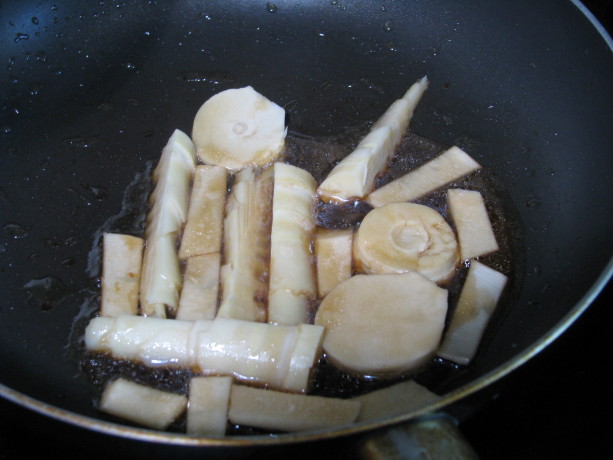
Frying up — yummy! So that’s another thing going on here at FFG. Thanks for wandering the bamboo lane with me.
TTFN!
Miranda (the Panda), B.S.
-
Celery Soup
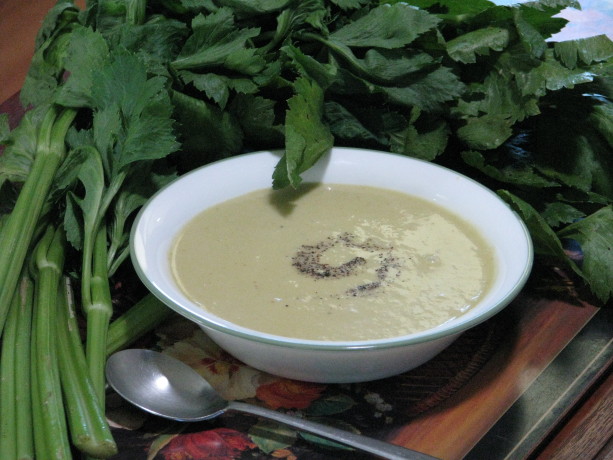
Celery soup, served hot or cold, is delicious and great for you! I thought I had posted this wonderful soup but apparently I hadn’t. Celery is a remarkable food for helping combat mental aging, among other attributes. This year we grew our own celery which is strong, fiberous and slightly bitter. We use it diced in stir-fry and many dishes including Celery Soup. This soup can be served hot or chilled, and you can either use cream at the end to finish it or just rely on the included potato for the thickener. Add a little cayenne to spice it up and increase its medicinal value. This is a blended soup that doesn’t freeze well (the flavor changes), so eat it all up! This is a lovely light green soup… great for Halloween! For another green soup, try my Zucchini and Rosemary Soup, too.
Celery SoupAuthor: Diane C. KennedyRecipe type: Main DishCuisine: AmericanPrep time:Cook time:Total time:Serves: 6 - 8This easy, delicious low-fat soup can be served hot or chilled, or dressed up with cream.Ingredients- ½ cup butter or butter substitute
- 10 ribs of celery (3½ cups) coarsely chopped (no leaves)
- ⅓ cup coarsely chopped shallots, or sliced leeks
- 1 small baking potato (russet-type) (6 oz), peeled and cubed
- Salt
- Pinch celery seed, ground (if using organic, stronger-flavored celery you may omit)
- ⅛th teaspoon cayenne pepper (optional)
- 6 cups vegetable broth
- ¼ teaspoon nutmeg
- ¼ cup heavy cream, or to taste (optional)
Instructions- Melt butter in a large saucepan over medium heat.
- Add celery, shallots or leeks, potato, celery seed and cayenne (if using), and a pinch of salt.
- Partially cover and cook, stirring occasionall,y until vegetables are soft but not browned, about 15 minutes.
- Add stock and bring to a simmer.
- Reduce heat to low, cover and cook 30 minutes.
- Stir in nutmeg.
- Allow to cool enough to be comfortable for you to puree in blender or food processor, in batches until completely smooth.
- If necessary pour through a fine sieve into a large bowl, pressing with a spoon to extract as much liquid as possible. If you have a Vitamix, just blend it on high and don't sieve.
- Return soup to pot, reheat slowly and adjust seasonings. (If serving cold, just adjust seasonings and chill.)
- Stir in cream (if using) and serve, garnished with celery leaves or croutons.
-
Fruit Tree Guild, Revisited
In June I blogged about how to plant a fruit tree guild, and gave the example of one I was planting by the Fowl Fortress. I thought I’d show you how it matured.

Apple tree in trouble: heavy clay thoroughly shot through with Bermuda grass. Yuck! This was the area four months ago. Heavy, sticky clay taken over with Bermuda grass. A struggling apple tree begs for my help. A star jasmine climbs the side of the Fowl Fortress. A portion of the brown subterranean irrigation system lies aboveground.
Using permaculture design, I created a plant guild with herbs and vegetables that would build the soil and help the apple tree.

A guild is planted. Strawberries went around the trunk of the tree for groundcover and grass competition. Comfrey, a valuable nutrient accumulator in there, too, for slash and drop fertilization. There is also a perennial basil, marjoram, gourds, golden runner bean (a nitrogen fixer), garlic chives, a prostrate rosemary and a tomato, along with other flower seeds. This is how it looks now from the same vantage point:
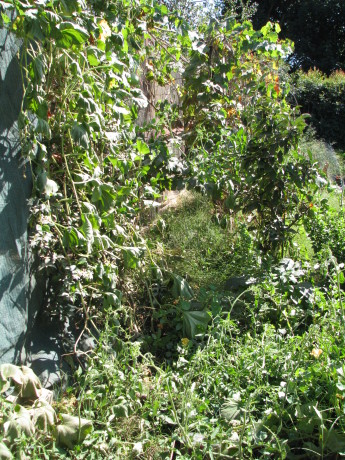
The guild in September. 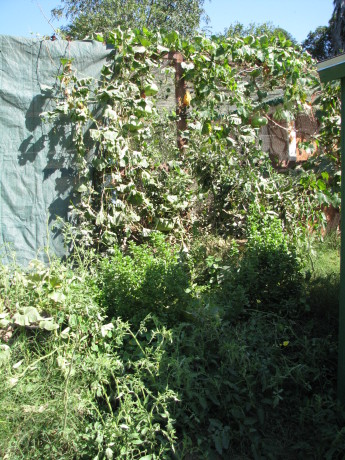
Layers of plants protect the ground and produce food. 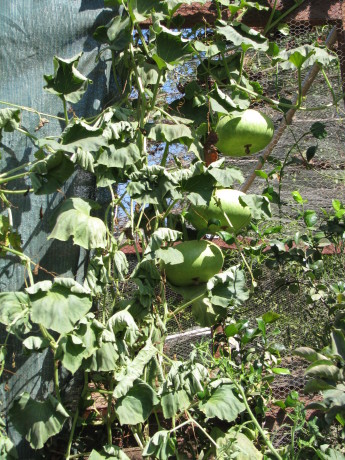
These gourds can be dried and made into bowls. 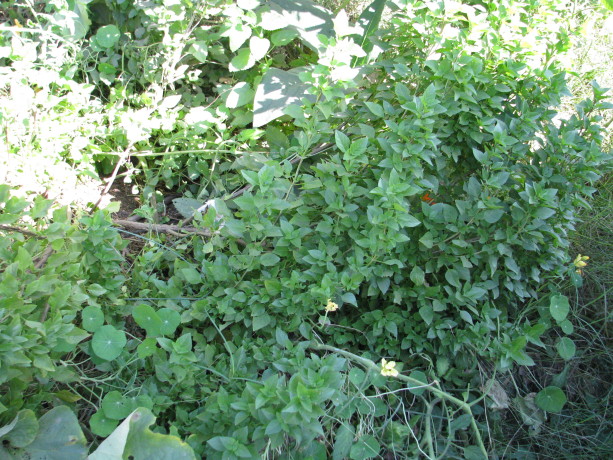
Perennial basil, Amish paste tomatoes smother the weeds and enrich the soil. 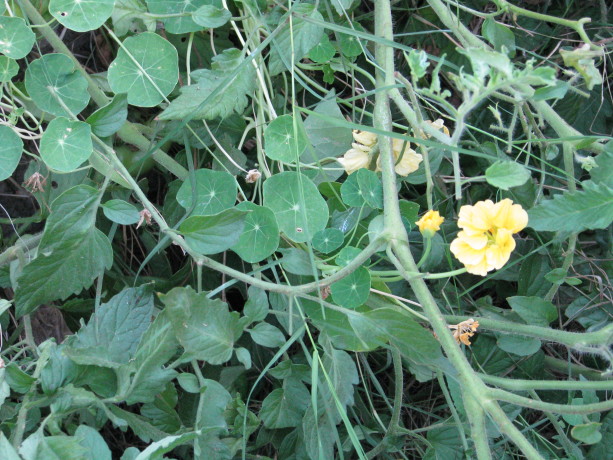
Nasturtiums reseed and fill in as the other vegetables die off. Polyculture beds produce abundant, insect-confusing food guilds which help fertilize and water each other and improve the soil quality. Meanwhile the apple tree has a few apples on it and looks healthier than it has been. Next year’s growth should be drastically improved, and the amount of invasive grasses should be nil. If I don’t grow consecutive annual crops here around the perennial plants, I will sheet mulch the bed.
- Compost, Gardening adventures, Health, Hugelkultur, Other Insects, Permaculture and Edible Forest Gardening Adventures, Soil, Vegetables, Worms
Don’t Clean Up, Dig It In!

Use old vegetables to grow new ones! Tomatoes, eggplant, peppers, fennel, carrots, string beans, three kinds of basil, and probably other things I’ve forgotten about! In January of this year I wrote about Lazy Composting. Frost had killed off sweet potato and tomato vines,
and the soil in the raised garden beds were becoming very low.

- Soil level is very low on the raised beds.
Instead of hauling all the vines to the compost heap or bin, I thought I’d create soil in place. The raised beds are lined with chicken wire to protect veggies from gophers. Although I didn’t want to disturb the microbes and fungus in the soil, I dug out half the beds down to the wire.
Then I layed all those vines right on the soil and covered them up.
Then I did the other half…
- Spent tomato vines, with some green ‘maters still attached.
… and then did the other bed. Any thick stalks in other beds which didn’t need extra soil I simply cut close to the ground so that their roots can decay in place and feed the wormies.
I sprinkled the whole thing with a little Epsom salts for the magnesium sulfate, and a little sugar to start the disturbed microbes feeding and reproducing heavily, which would cause them to decompose the vines more quickly.
In one bed I planted cold weather crops right away; peas, brassicas, garlic, onions and more. I am a firm practicioner of polyculture, or integrated gardening , which means that I plant an assortment of seeds of plants which will help each other in small areas instead of planting all one thing to a bed. I can still plant a row of peas so that I can string them up easily, but I’ll plant all kinds of other plants around them. Usually I don’t plant in a line at all anymore, but rather stake the plants as they need them. Often they’ll use taller plants as support. This is why planting peas and sweet peas next to trees and bushes is a great idea (they fix nitrogen in the soil which helps the tree).
In the other bed I waited to plant until March when the weather warmed up, because I was planting early summer crops. Here it is the beginning of September, and here are the beds, still producing. Even the winter veg one.
In the bed to the right there is a yellow current tomato blocking the view, and growing into the tree. You can see a Japanese eggplant, and behind it the red is a pepper. Under the tomato and along the bed are three kinds of basil, many string bean plants, some of the sweetest carrots we’ve grown, fennel (one of which we allowed to be the host plant for the Anise Swallowtail, which ate the tops. The bottom of the fennel, which is the part we eat, will still be harvestable). In the bed to the right is the January plants still alive and kicking. Collards, kale, garlic, celery, onions, brussels sprouts, kohlrahbi and more. We’ve harvested most of the garlic and onions. We’ve harvested kale, collards and celery by cutting leaves and allowing the plant to continue to grow. The stalks are now so thick that it is hard to cut them. Out of season, these plants have had attack by cabbage moths and other bugs, but because of the integration of plants and the health of the soil, they’ve bounced right back. I’m harvesting the plants now to feed to the chickens so that I can use the bed for something else soon.
So what happened? A teaspoon of great soil has a billion microbes in it, a million fungi, tens of thousands of amebas, bacteria and all kinds of things we don’t even know about yet. This is a good thing. This is the secret to continued life on this planet. Healthy soil doesn’t wash away, doesn’t erode, feeds the underground waterways, grows excellent food for healthy wildlife and healthy humans. If we feed the soil, we save the planet. That simple. That means no Roundup, no GMOs, no chemical (even organic) fertilizer. Just compost. Very cheap and easy.
Vegetables tend to like a soil that is heavier in bacteria than in fungus, although both should be present. Woody plants such as bushes and trees tend to like a more fungal soil. The vines that I buried had both dry (stems) and wet (green leaves and tomatoes) on them. The stems made the fungus flourish in the soil, and the green bits made the bacteria active. There wasn’t enough matter to become anaerobic, or to rob nitrogen from the soil. The vines weren’t compacted so lots of soil surrounded all the parts, aiding in quick composting and keeping the soil aerated. Water could be absorbed better as well.
If you are starting a garden and want to buy compost, be careful of what stores sell you. In August I was asked to look at a few raised beds that hadn’t succeeded. The soil was low in the beds, there were a few straggly pepper plants, a poorly tomato and some brassicas of some sort which were so stunted that they were just green balls of leaves. When I pulled one up there was white stuff on the roots. A couple of strawberry plants looked very healthy but unproductive. I tried the soil and couldn’t get my finger into it because the roots from those poor peppers had made a thick mat just under the surface of the dirt well beyond their dripline. Two major things were wrong. One was the dirt in the beds. Splinters of shredded wood made up the bulk of it. The woman who had asked me to look at the beds said that she had described her project at Home Depot and they’d recommended two kinds of bagged stuff. I say stuff, because it isn’t soil. What they recommended would be appropriate for hardwoods such as bushes and trees, or acid-loving plants. That is why the strawberries were healthy, only they were in the full sun in a searing hot place and would have done much better under the shade of other plants. I showed the white stuff on the brassicas to her; it was fungal net, which showed the high fungal activity in the soil. Perfect for trees, not perfect for vegetables. Also the brassicas are cold-weather plants and just won’t develop in our summer heat here in San Diego County. They should be planted from October through the beginning of March. The spongy soil… honestly, I’ve never before felt root mat so thick that I couldn’t wiggle my finger into the soil… was the result of desperate plants and poor watering. A custodian would occasionally hose water the beds, which meant that he’d shoot some water on them for a few minutes every day or so. This topical water didn’t sink into the bark-heavy soil. It was only enough to water the top, so the plant roots couldn’t go deep. It was often enough that the plants didn’t die entirely, but survived stunted and striving for water and nutrition that the fungal soil wasn’t providing. Vegetables (and roses!); indeed, most plants except grasses and seedlings, need deep watering less frequently. This allows the roots to go where they want to go, deep into the ground where they can mine nutrients and stabilize the plant. My advice for her was to dig in the few plants that were there, use the compost in the compost bin next to the beds, even if it wasn’t decomposed and add some vegetable-friendly soil to the beds to bring up the heighth. I recommended mixing seeds and scattering them, making sure she planted winter crops, not corn or tomatoes. I also recommended a long watering twice a week; none when it starts raining. If it ever does.
Recommending permaculture techniques to people makes me want to work in the garden! That is because there is so much life, so much success, so many happy surprises and such great feelings that come out of naturally planted gardens. Rows of veggies look so neat and peaceful, but beds chock full of veggies are more fun, better tasting and far more productive.
I just wanted to follow up on the old post about digging in the vines and show you how well the plants did. I have never fertilized these beds after burying the vines and sprinkling on the Epsom salts and sugar. All this growth is due to the happy microbes making nutrients available to the vegetable roots. If you think about it, plants in the wild shed their seeds and then either completely die off or drop leaves. The seeds naturally grow up through the debris of the last generation. Makes sense, doesn’t it?
When these beds are done (if they ever are! They keep producing!) I will practice no-dig gardening on them and simply cut all the plants at the soil surface and drop the tops. I’ll plant seeds for winter crops right in among the debris of the summer crops. They’ll use the nutrients, shade and support of the old crops to grow. October is a good planting time for winter crops because the weather finally changes and the daylight hours are shorter which these plants need. What to plant? Potatoes, garlic, onions, Brussels sprouts, cabbage, peas, broccoli, cauliflower, rhubarb, kohlrabi, celery and much more. Cover crops when it frosts and allow good drainage for the potatoes when it rains. Be sure if you buy starter sets that they are guaranteed organic! Best of all plant organic seeds… they do the best of all and are the best value.
Have a happy, easy Fall garden!
